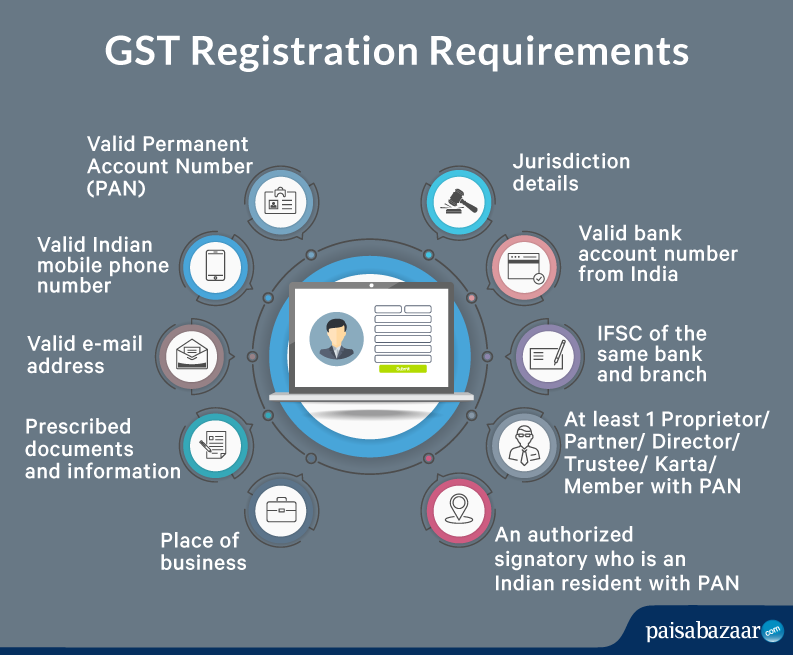Understanding GST Enrollment: Crucial Actions to Make Sure Regulatory Compliance and Business Development
Browsing the world of Goods and Services Tax (GST) registration can be a pivotal step for organizations intending to preserve compliance and foster development. The elaborate procedure of registering for GST requires an eager understanding of the necessary steps included, from understanding the basic principles of GST to thoroughly preparing the required paperwork. Nonetheless, past just ticking off the governing checkboxes, mastering GST enrollment opens a world of possibilities for services to purposefully leverage this tax framework to move their development. Understanding the subtleties of GST registration is not just a governmental requirement yet a critical step that can shape the trajectory of a service towards sustainable success.
Recognizing GST Essentials
Understanding the fundamentals of Item and Solutions Tax Obligation (GST) is crucial for organizations to navigate the complexities of tax conformity and monetary monitoring efficiently. GST is a value-added tax obligation levied on the supply of products and solutions in India, intending to produce a unified tax system across the country. Singapore GST Registration. Under GST, companies require to register and acquire a distinct GSTIN (Goods and Services Tax Recognition Number) to be certified with the legislation

Readying Necessary Files
To ensure conformity with GST enrollment needs, businesses have to gather and organize the necessary files for the application procedure efficiently. The key records commonly needed for GST registration consist of proof of business registration or consolidation, frying pan card of the company, address and identification proofs of marketers, photographs, bank declarations, and proof of address of the workplace. Additionally, companies may need to give details of licensed signatures, service activities, and turn over. It is critical to guarantee that all papers are accurate, as much as date, and meet the requirements defined by the tax obligation authorities to stay clear of delays or beings rejected in the enrollment procedure.
Organizing these files in a methodical way can streamline the application process and demonstrate business's commitment to regulatory compliance. Services must maintain both physical and digital copies of these papers for very easy gain access to and recommendation. By preparing the necessary records vigilantly, businesses can accelerate their GST enrollment procedure and concentrate on their core procedures with the guarantee of governing compliance.
Online Registration Process
Begin the GST registration process by navigating to the official online site marked for organization enrollment. When the account is set up, you can continue with loading out the GST registration application type by going into the needed service info, including service address, turnover, and kind details.

Conformity and Coverage Commitments
Upon effective enrollment on the GSTN site and conclusion of the required documents, organizations need to stick to stringent compliance and reporting responsibilities to guarantee governing adherence and operational openness. Compliance needs under GST required prompt and precise filing of different returns, such as GSTR-1 for exterior products, GSTR-3B for regular monthly summary returns, and yearly returns like GSTR-9. Additionally, organizations require to reconcile their sales and acquisition information via GSTR-2A and GSTR-2B to claim input tax debts properly.
Preserving appropriate records of billings, accounting papers, and other relevant data is critical for GST conformity. Routine audits and assessments by tax authorities necessitate companies to have precise documentation and reporting systems in place. Any type of inconsistencies or non-compliance can lead Check This Out to penalties, have a peek here fines, and even suspension of GST enrollment.
To streamline compliance procedures, businesses can leverage GST compliance software program that automates return conformity, filing, and reconciliation tracking. Staying updated with regulative modifications and looking for professional suggestions when required can further improve compliance efforts and guarantee smooth procedures within the GST framework.
Leveraging GST for Organization Development
Organizations can strategically make use of the GST structure to drive lasting growth and boost functional efficiency (Singapore GST Registration). Leveraging GST for business development involves greater than simply conformity; it provides an opportunity for firms to improve processes and optimize their financial operations. One key advantage of GST is the input tax credit system, which enables companies to declare credit ratings for tax obligations paid on inputs. By effectively taking care of input tax obligation credit histories, business can minimize their overall tax obligation obligation and enhance capital. Additionally, GST advertises transparency and liability in the tax obligation system, which can help organizations develop trust fund with customers and partners.
Moreover, GST registration can likewise open up brand-new markets for businesses. In essence, leveraging GST for service development includes strategic preparation, reliable compliance, and a forward-looking technique to economic management.
Final Thought
Finally, grasping GST registration is critical for ensuring governing compliance and assisting in service development. By understanding the basics of GST, preparing necessary records, finishing the on the internet enrollment process, and fulfilling compliance and reporting obligations, organizations can take advantage of GST to their advantage. It is important for companies to comply with the policies and utilize GST as a tool for expanding their operations and remaining competitive on the market.
Navigating the world of Item and Provider Tax (GST) registration can be a critical action for organizations aiming to maintain compliance and foster growth. The key documents generally required for GST registration include evidence of company enrollment or unification, PAN card of the business, identity and address evidence of marketers, photos, bank statements, and proof of address of the area of business.Begin the GST enrollment process by navigating to the official online portal designated for company enrollment. Once the account is established up, you can proceed with filling up out the GST enrollment application kind by going into the essential organization info, consisting of organization type, address, and turnover information.
By comprehending the Singapore GST Registration essentials of GST, preparing necessary records, completing the on the internet registration process, and meeting compliance and reporting commitments, companies can leverage GST to their advantage.